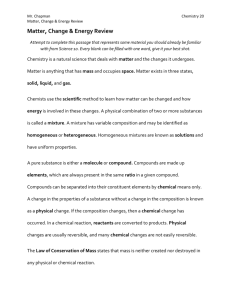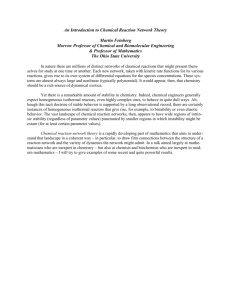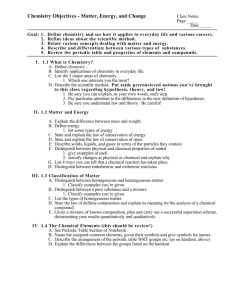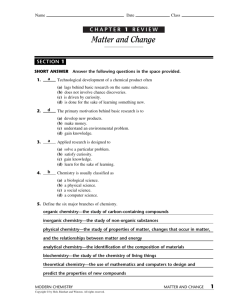Chemistry Answer Key - Chapter 1 Solutions
advertisement
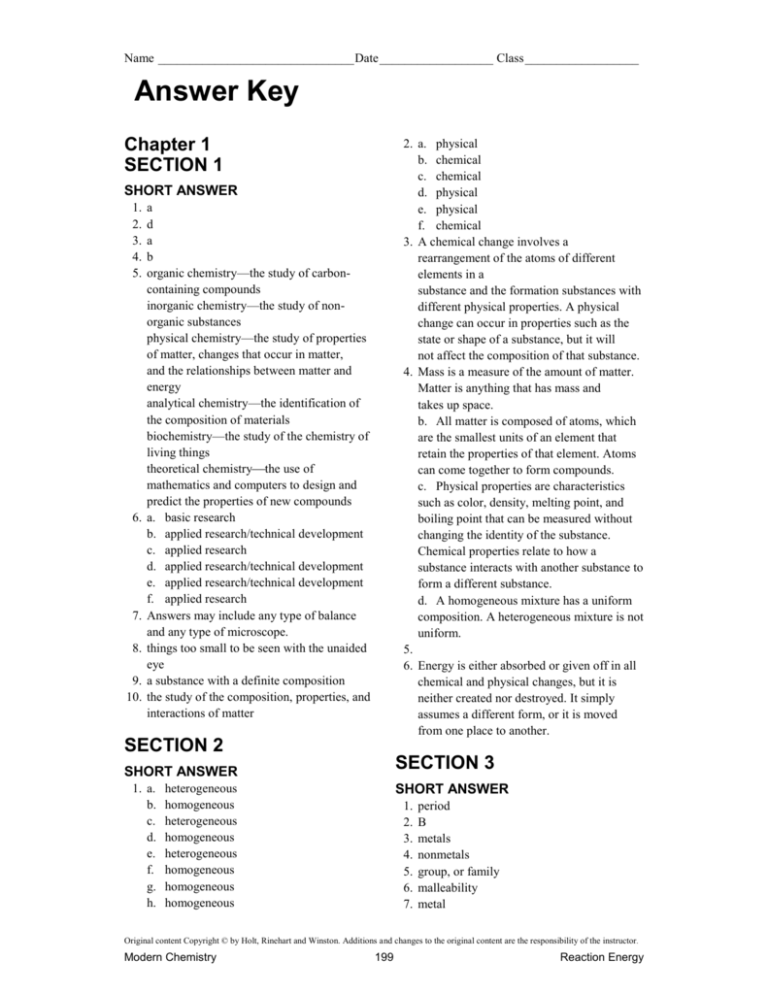
Name _______________________________ Date __________________ Class __________________ Answer Key Chapter 1 SECTION 1 2. a. physical b. chemical c. chemical d. physical e. physical f. chemical 3. A chemical change involves a rearrangement of the atoms of different elements in a substance and the formation substances with different physical properties. A physical change can occur in properties such as the state or shape of a substance, but it will not affect the composition of that substance. 4. Mass is a measure of the amount of matter. Matter is anything that has mass and takes up space. b. All matter is composed of atoms, which are the smallest units of an element that retain the properties of that element. Atoms can come together to form compounds. c. Physical properties are characteristics such as color, density, melting point, and boiling point that can be measured without changing the identity of the substance. Chemical properties relate to how a substance interacts with another substance to form a different substance. d. A homogeneous mixture has a uniform composition. A heterogeneous mixture is not uniform. 5. 6. Energy is either absorbed or given off in all chemical and physical changes, but it is neither created nor destroyed. It simply assumes a different form, or it is moved from one place to another. SHORT ANSWER 1. 2. 3. 4. 5. 6. 7. 8. 9. 10. a d a b organic chemistry—the study of carboncontaining compounds inorganic chemistry—the study of nonorganic substances physical chemistry—the study of properties of matter, changes that occur in matter, and the relationships between matter and energy analytical chemistry—the identification of the composition of materials biochemistry—the study of the chemistry of living things theoretical chemistrythe use of mathematics and computers to design and predict the properties of new compounds a. basic research b. applied research/technical development c. applied research d. applied research/technical development e. applied research/technical development f. applied research Answers may include any type of balance and any type of microscope. things too small to be seen with the unaided eye a substance with a definite composition the study of the composition, properties, and interactions of matter SECTION 2 SECTION 3 SHORT ANSWER 1. a. b. c. d. e. f. g. h. SHORT ANSWER heterogeneous homogeneous heterogeneous homogeneous heterogeneous homogeneous homogeneous homogeneous 1. 2. 3. 4. 5. 6. 7. period B metals nonmetals group, or family malleability metal Original content Copyright © by Holt, Rinehart and Winston. Additions and changes to the original content are the responsibility of the instructor. Modern Chemistry 199 Reaction Energy Name _______________________________ Date __________________ Class __________________ 8. noble gases 9. solids 10. They are brittle, are poor conductors of heat and electricity, and have low boiling points. 11. They are malleable, ductile, and good conductors of heat and electricity, and they have a metallic (shiny) luster. 12. They are semiconductors of electricity, solid at room temperature, and less malleable than metals. 13. They are in the gas state at room temperature and are generally unreactive. 14. Elements of the same group share similar chemical properties. 15. The properties of elements that are close to each other in the same period tend to be more similar than the properties of elements that are far apart. Physical and chemical properties change somewhat regularly across a period. 16. You would consider an element of the same vertical column, or group, because elements in the same group have similar chemical properties. 17. Family is another name for group, or elements in the same vertical column. Elements in the same period are in the same horizontal row. 18. 4. a. chlorine, Group 17, Period 3 b.magnesium, Group 2, Period 3 c.tungsten, Group 6, Period 6 d.iron, Group 8, Period 4 e.tin,Group 14, Period 5 5. Extensive properties depend on the amount of matter present; intensive properties do not. 6. The burning of gasoline represents a chemical change because the gasoline is being changed into substances with different identities. Evaporation involves a physical change; the identity of gasoline remains unchanged. 7. A heterogeneous mixture, such as blood, is made of components with different physical properties. A homogeneous mixture, such as stainless steel, has a single set of physical properties. 8. MIXED REVIEW Chapter 2 SECTION 1 SHORT ANSWER 1. a. homogeneous b. homogeneous c. heterogeneous d. homogeneous e. heterogeneous 2. a. analytical chemistry b. theoretical chemistry/biochemistry c. biochemistry d. organic chemistry e analytical chemistry f. biochemistry/analytical chemistry 3. a. basic research b. applied research c. applied research/technological development d. basic research/applied research e. basic research SHORT ANSWER 1. a. observation and data b. observation and data c. control d. hypothesis 2. Quantitative values include the mass of sugar, volume of water, and observed freezing point. Qualitative properties are the color and state of the sugar and the claim of greater density. 3. Theories are broad generalizations used to explain observations. Models are a physical object used to illustrate or explain complex concepts or an explanation of how phenomena occur and how data and events are related. 4. The model of the sun accurately shows that the sun is round and has a fiery surface, Original content Copyright © by Holt, Rinehart and Winston. Additions and changes to the original content are the responsibility of the instructor. Modern Chemistry 200 Reaction Energy

